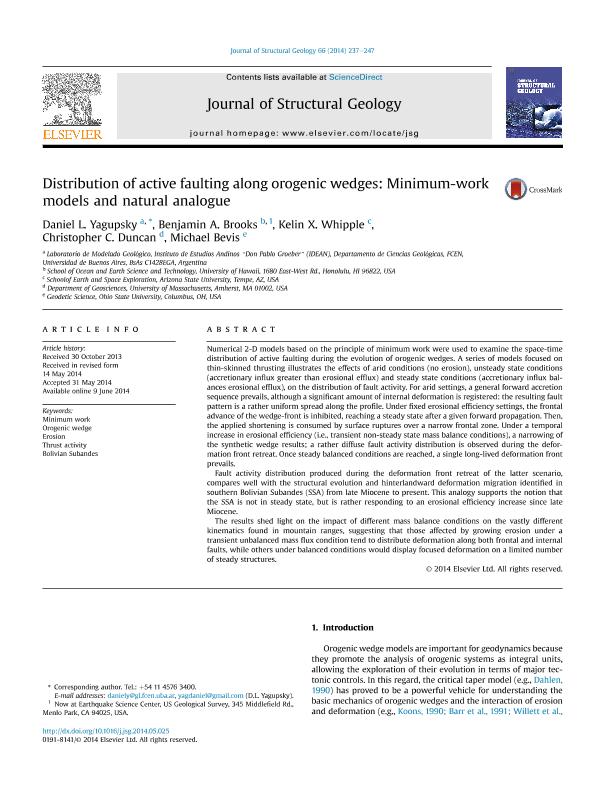Artículo
Distribution of active faulting along orogenic wedges: Minimum-work models and natural analogue
Yagupsky, Daniel Leonardo ; Brooks, Benjamin A.; Whipple, Kelin X.; Duncan, Christopher C.; Bevis, Michael
; Brooks, Benjamin A.; Whipple, Kelin X.; Duncan, Christopher C.; Bevis, Michael
 ; Brooks, Benjamin A.; Whipple, Kelin X.; Duncan, Christopher C.; Bevis, Michael
; Brooks, Benjamin A.; Whipple, Kelin X.; Duncan, Christopher C.; Bevis, Michael
Fecha de publicación:
09/2014
Editorial:
Elsevier
Revista:
Journal Of Structural Geology
ISSN:
0191-8141
Idioma:
Inglés
Tipo de recurso:
Artículo publicado
Clasificación temática:
Resumen
Numerical 2-D models based on the principle of minimum work were used to examine the space-time distribution of active faulting during the evolution of orogenic wedges. A series of models focused on thin-skinned thrusting illustrates the effects of arid conditions (no erosion), unsteady state conditions (accretionary influx greater than erosional efflux) and steady state conditions (accretionary influx balances erosional efflux), on the distribution of fault activity. For arid settings, a general forward accretion sequence prevails, although a significant amount of internal deformation is registered: the resulting fault pattern is a rather uniform spread along the profile. Under fixed erosional efficiency settings, the frontal advance of the wedge-front is inhibited, reaching a steady state after a given forward propagation. Then, the applied shortening is consumed by surface ruptures over a narrow frontal zone. Under a temporal increase in erosional efficiency (i.e., transient non-steady state mass balance conditions), a narrowing of the synthetic wedge results; a rather diffuse fault activity distribution is observed during the deformation front retreat. Once steady balanced conditions are reached, a single long-lived deformation front prevails. Fault activity distribution produced during the deformation front retreat of the latter scenario, compares well with the structural evolution and hinterlandward deformation migration identified in southern Bolivian Subandes (SSA) from late Miocene to present. This analogy supports the notion that the SSA is not in steady state, but is rather responding to an erosional efficiency increase since late Miocene. The results shed light on the impact of different mass balance conditions on the vastly different kinematics found in mountain ranges, suggesting that those affected by growing erosion under a transient unbalanced mass flux condition tend to distribute deformation along both frontal and internal faults, while others under balanced conditions would display focused deformation on a limited number of steady structures.
Palabras clave:
Minimum Work
,
Orogenic Wedge
,
Erosion
,
Thrust Activity
,
Bolivian Subandes
Archivos asociados
Licencia
Identificadores
Colecciones
Articulos(IDEAN)
Articulos de INSTITUTO DE ESTUDIOS ANDINOS "DON PABLO GROEBER"
Articulos de INSTITUTO DE ESTUDIOS ANDINOS "DON PABLO GROEBER"
Citación
Yagupsky, Daniel Leonardo; Brooks, Benjamin A.; Whipple, Kelin X.; Duncan, Christopher C.; Bevis, Michael; Distribution of active faulting along orogenic wedges: Minimum-work models and natural analogue; Elsevier; Journal Of Structural Geology; 66; 9-2014; 237-247
Compartir
Altmétricas



